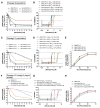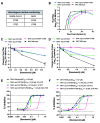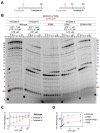Mutations in the SARS-CoV-2 RNA-dependent RNA polymerase confer resistance to remdesivir by distinct mechanisms
- PMID: 35482820
- PMCID: PMC9097878
- DOI: 10.1126/scitranslmed.abo0718
Mutations in the SARS-CoV-2 RNA-dependent RNA polymerase confer resistance to remdesivir by distinct mechanisms
Abstract
The nucleoside analog remdesivir (RDV) is a Food and Drug Administration-approved antiviral for treatment of severe acute respiratory syndrome coronavirus 2 (SARS-CoV-2) infections. Thus, it is critical to understand factors that promote or prevent RDV resistance. We passaged SARS-CoV-2 in the presence of increasing concentrations of GS-441524, the parent nucleoside of RDV. After 13 passages, we isolated three viral lineages with phenotypic resistance as defined by increases in half-maximal effective concentration from 2.7- to 10.4-fold. Sequence analysis identified nonsynonymous mutations in nonstructural protein 12 RNA-dependent RNA polymerase (nsp12-RdRp): V166A, N198S, S759A, V792I, and C799F/R. Two lineages encoded the S759A substitution at the RdRp Ser759-Asp-Asp active motif. In one lineage, the V792I substitution emerged first and then combined with S759A. Introduction of S759A and V792I substitutions at homologous nsp12 positions in murine hepatitis virus demonstrated transferability across betacoronaviruses; introduction of these substitutions resulted in up to 38-fold RDV resistance and a replication defect. Biochemical analysis of SARS-CoV-2 RdRp encoding S759A demonstrated a roughly 10-fold decreased preference for RDV-triphosphate (RDV-TP) as a substrate, whereas nsp12-V792I diminished the uridine triphosphate concentration needed to overcome template-dependent inhibition associated with RDV. The in vitro-selected substitutions identified in this study were rare or not detected in the greater than 6 million publicly available nsp12-RdRp consensus sequences in the absence of RDV selection. The results define genetic and biochemical pathways to RDV resistance and emphasize the need for additional studies to define the potential for emergence of these or other RDV resistance mutations in clinical settings.
Figures






References
-
- CDC, COVID Data Tracker, Cent. Dis. Control Prev . (2020), (available at https://covid.cdc.gov/covid-data-tracker).
-
- W. H. O. Coronavirus, (COVID-19) Dashboard, (available at https://covid19.who.int).
-
- Warren T. K., Jordan R., Lo M. K., Ray A. S., Mackman R. L., Soloveva V., Siegel D., Perron M., Bannister R., Hui H. C., Larson N., Strickley R., Wells J., Stuthman K. S., Van Tongeren S. A., Garza N. L., Donnelly G., Shurtleff A. C., Retterer C. J., Gharaibeh D., Zamani R., Kenny T., Eaton B. P., Grimes E., Welch L. S., Gomba L., Wilhelmsen C. L., Nichols D. K., Nuss J. E., Nagle E. R., Kugelman J. R., Palacios G., Doerffler E., Neville S., Carra E., Clarke M. O., Zhang L., Lew W., Ross B., Wang Q., Chun K., Wolfe L., Babusis D., Park Y., Stray K. M., Trancheva I., Feng J. Y., Barauskas O., Xu Y., Wong P., Braun M. R., Flint M., McMullan L. K., Chen S.-S., Fearns R., Swaminathan S., Mayers D. L., Spiropoulou C. F., Lee W. A., Nichol S. T., Cihlar T., Bavari S., Therapeutic efficacy of the small molecule GS-5734 against Ebola virus in rhesus monkeys. Nature 531, 381–385 (2016). 10.1038/nature17180 - DOI - PMC - PubMed
-
- Sheahan T. P., Sims A. C., Graham R. L., Menachery V. D., Gralinski L. E., Case J. B., Leist S. R., Pyrc K., Feng J. Y., Trantcheva I., Bannister R., Park Y., Babusis D., Clarke M. O., Mackman R. L., Spahn J. E., Palmiotti C. A., Siegel D., Ray A. S., Cihlar T., Jordan R., Denison M. R., Baric R. S., Broad-spectrum antiviral GS-5734 inhibits both epidemic and zoonotic coronaviruses. Sci. Transl. Med. 9, eaal3653 (2017). 10.1126/scitranslmed.aal3653 - DOI - PMC - PubMed
-
- Agostini M. L., Andres E. L., Sims A. C., Graham R. L., Sheahan T. P., Lu X., Smith E. C., Case J. B., Feng J. Y., Jordan R., Ray A. S., Cihlar T., Siegel D., Mackman R. L., Clarke M. O., Baric R. S., Denison M. R., Coronavirus Susceptibility to the Antiviral Remdesivir (GS-5734) Is Mediated by the Viral Polymerase and the Proofreading Exoribonuclease. mBio 9, e00221–e18 (2018). 10.1128/mBio.00221-18 - DOI - PMC - PubMed
Publication types
MeSH terms
Substances
Grants and funding
LinkOut - more resources
Full Text Sources
Research Materials
Miscellaneous

